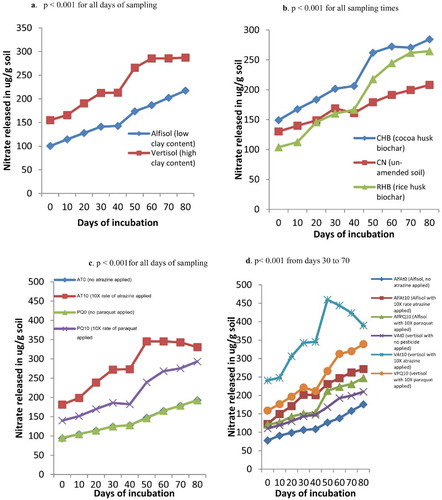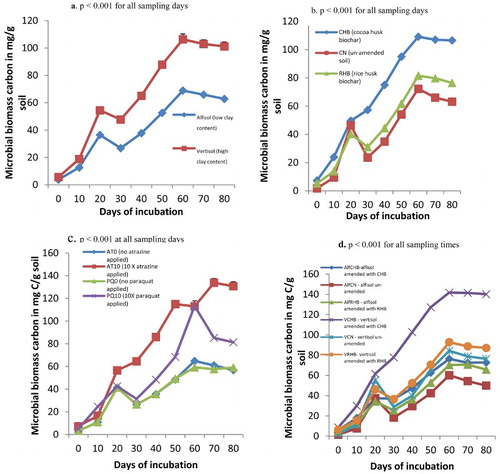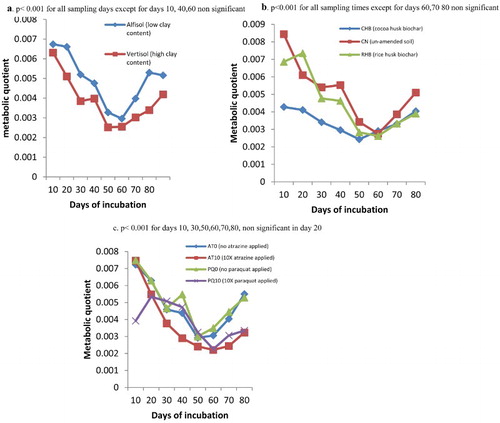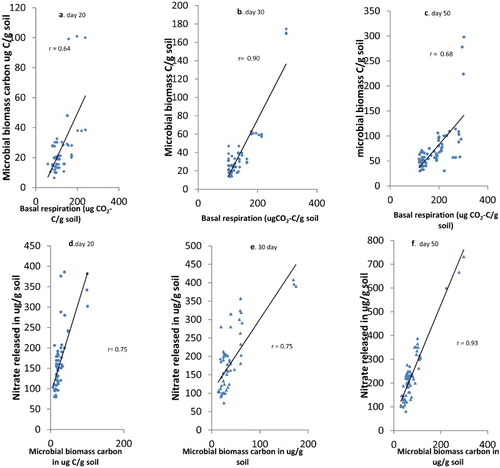Figures & data
Table 1. Some physico-chemical properties of the soils and biochar used for the greenhouse incubation study.
Figure 1. XRD spectra of biochars (CHB and RHB). Note: A = silica (SiO2), F = periclase (MgO), G = magnesium oxide (MgO), H = magnesium carbonate (MgCO3), I = potassium hydrogen carbonate (KHCO3), J = aluminium iron (iii) oxide (AlFeO3), K = iron oxide hydroxide (FeOOH), P = magnesium hydroxide (Mg[OH]2).
![Figure 1. XRD spectra of biochars (CHB and RHB). Note: A = silica (SiO2), F = periclase (MgO), G = magnesium oxide (MgO), H = magnesium carbonate (MgCO3), I = potassium hydrogen carbonate (KHCO3), J = aluminium iron (iii) oxide (AlFeO3), K = iron oxide hydroxide (FeOOH), P = magnesium hydroxide (Mg[OH]2).](/cms/asset/5371b6ab-5099-47b4-a1d9-0814de065f5c/sagb_a_1302504_f0001_c.jpg)
Figure 2. (a) Ammonia released from soils of different clay contents, (b) soils amended with biochar of different feed stocks and (c) soils contaminated with different rates of pesticides (atrazine and paraquat) in a greenhouse incubation study.

Figure 3. (a) Nitrate released from soils of different clay contents, (b) soils amended soil with biochar of different feed stocks, (c) soils contaminated with different rates of pesticides (atrazine and paraquat) and (d) soil × pesticide interaction during a greenhouse incubation study.

Table 2. Ammonification, nitrification and carbon mineralization rates of soils amended with biochar of different feed stocks and contaminated with pesticides (atrazine and paraquat) of various rates.
Figure 4. (a) Microbial biomass carbon of soils of different clay content, (b) soils amended with biochar of different feed stocks, (c) soils contaminated with different rates of pesticides (namely atrazine and paraquat) and (d) soil × biochar interaction during an incubation study in the greenhouse.

Figure 5. (a) Basal respiration as measured as carbon dioxide carbon evolved from soils of different clay contents, (b) soils amended with biochar of different feed stocks, (c) soils contaminated with pesticides (atrazine and paraquat) at different rates and (d) soil × pesticide interaction during an incubation study in the greenhouse.

Figure 6. (a and b) Carbon mineralization in the alfisol and vertisol when no has been pesticide applied (i.e. 0 kg a.i/ha atrazine and paraquat applied), (c) carbon mineralization in the alfisol contaminated with 10× the normal rate of atrazine and paraquat and (d) carbon mineralization in the vertisol contaminated with 10× the normal rate of atrazine and paraquat during a greenhouse incubation study.

Figure 7. (a) Metabolic quotient of soils of different clay content, (b) soils amended with biochar of different feed stocks and (c) soils contaminated with different rates of pesticides (atrazine and paraquat) during an incubation study in the greenhouse.

Figure 8. (a–c) Correlation between micobial biomass carbon and basal respiration at days 20, 30 and 50. (d–f) Correlation between microbial biomass carbon and nitrate released at days 20, 30 and 50 days of incubating soils with different biochar amendments and polluted with pesticides. r is the correlation coefficient.

